The Illustrated Chapin
John Reuben Chapin, (1823-1904)
By Judy Chapin Buzby
A little remembered but talented, wood cut engraver, illustrator, and watercolorist has some interesting ties to Buffalo, New York. John Reuben Chapin was a distant cousin to Cyreneus Chapin, the physician who helped rebuild Buffalo after the War of 1812 and they are both direct descendents of the illustrious Deacon Samuel Chapin who was a leader in the village of Springville, MA. in 1642. That town today boasts a Saint-Gaudens statue, “The Pilgrim” that is modeled after a portrait of Deacon Samuel Chapin.
Chapin moved to Buffalo in 1870 with his wife and five children. Here, he opened the western branch of his Company, The Bureau of Illustration. This company was associated with Sage, Sons and Co. and they hired six or seven craftsmen that did illustrations for the Buffalo Directories and many local companies. Chapin’s work can be seen in the Portfolio of the Bureau of Illustration that he published in the 1870’s. One copy remains in the Buffalo and Erie County Historical Society.
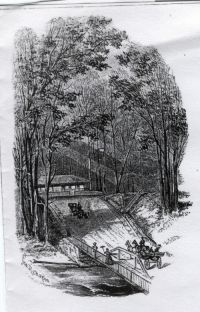
One of Chapin's woodcut illustrations that was done while living and working in Buffalo
The family stayed in Buffalo for a few short years and then moved on. In 1890 John R and his wife moved back to Buffalo and lived with his son, Charles Pierson Chapin. He continued to work as a free-lance illustrator and watercolorist until his death in 1904.
Encouragement From Morse
John Ruben Chapin was born in 1823 to Loring Dudly Chapin and Emaline Amelia Thurber. His father was a maker of musical instruments and had a great love of books. His mother was a learned woman and came from a well-known family in Providence R.I.
The Chapin’s moved to New York City in 1830 where John attended a “Normal School”. He was talented in art and spent all of his spare time copying any picture that he could find. At that time, there were few illustrations in books or magazines and none in newspapers. He was especially lucky that his father was a bibliophile and had a supply of illustrated books to use as examples so that John could practice his craft.
In 1840, at the urging of Samuel F. B. Morse, a family friend, he attended the Academy of Design on the corner of Leonard St. and Broadway where Mr. Morse was a Professor of the Arts. Although Morse wasn’t present very often, he provided the students with encouragement during his occasional visits and used his artistic talents to give them advice on their endeavors. On a day-to-day basis, the students practiced and drew with critique from each other and the teachers at the school.
It is difficult for us to appreciate the fact that there were so few illustrations in print at that time. We are so used to the instant gratification of seeing pictures on our digital cameras and on television. Our newspapers are full of pictures. In the early 19th century, there was no such luxury. The importance of woodcut illustration cannot be underestimated. It provided a method whereby multiples of an image could be printed relatively quickly and inexpensively so that newspapers and magazines could give the common person visual information that might ultimately change their lives. No longer did a person need to apprentice for a trade, there were illustrated books and articles about construction, electricity, and all manner of important things. “Ideas, once fixed on paper, could be shared with others and become something more than figments of one person’s imagination,” according to Diana Korzenik in her study of the era's illustrative significance, Drawn to Art, A Nineteenth Century American Dream. Thus, Chapin was among those that helped to shape our country through artistic passion.
In 1842, Loring Dudly Chapin was serving in the New York State Legislature and secured an appointment to West Point for his son John. This was not the career path that John wanted to follow, as his passion was art. Samuel F.B. Morse interceded with the family and achieved a compromise; John was to study law. Starting as a Law clerk with a lawyer in New York City, he soon found that a fellow law clerk in the office had purchased wood engraving instruments and didn’t have the talent or inclination for that endeavor. After 6 months as a clerk, John R. was able to buy the wood engraving materials and strike off on his own. He moved to Boston the next year and was able to sell an idea to Gleason’s Pictorial Magazine that allowed him to visit small towns in the south. Here he wrote and illustrated articles about places of interest in these towns. John R’s daughter, Hattie, in her autobiography from 1934, remembers seeing an article from that time that he produced called “The Byrd Estate of Virginia”. She was impressed because the article was about the ancestral home of Commander Richard Byrd, the well-known explorer, aviator, and navigator of the 20th century, who was much in the news in the 20’s and 30’s.
The Inventive Illustrator
From 1850-1860 John R worked out of New York City and did free lance illustrations for books, magazines, and the patent office in Washington. Many of the well-known inventors were his friends and he did the illustrations for their patents. Some of these men included, Cyrus McCormack who invented the reaper, Walter Hunt, the Springfield Rifle, along with the lowly safety pin, and George Gordon who invented the hand printing press. During this time he was still involved with Samuel F.B. Morse and frequently helped Morse financially. It took much money and lobbying to get the US Congress to appropriate money to put up a telegraph line between Baltimore and Washington. John R. was convinced that Samuel Morse’s invention of the telegraph was going to revolutionize the world and therefore he provided support and money to Morse.
He was married, in 1848, to Martha C. Shannon of Providence, RI and their first child; Henry Albert was born in 1849. They settled in Rahway NJ in 1854 with 3 children, Henry, Harriet, and Freelove. The home was large and they employed seven colored servants to help with the children and the house. While living in Rahway, they had four more children, Isabella, Will, Charles, and Henry Stephen.
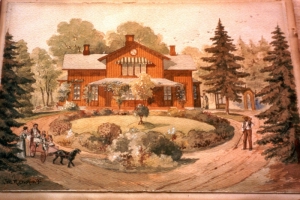
Watercolor done by Chapin depicting his home and family, in Rahway, NJ
In 1857 several tragedies occurred that devastated John and Martha. Two children died in one month; Henry, their oldest and their idol, and Isabella, the youngest at that time. They were crushed and this loss was further magnified up by the panic of 1857, which seriously disturbed the lives of many people.
Chapin quickly recouped his losses and since Rahway was situated on the Pennsylvania Railroad line, he took the train to New York or to Washington for his work. In 1874 he painted a pair of charming watercolors that depicted the last stagecoach and the first train coming through Rahway.
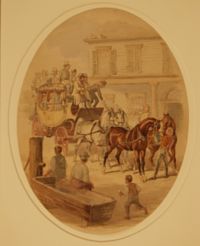
Stage coach stop, 1874 watercolor
Private Collection, photo Barbi Lare
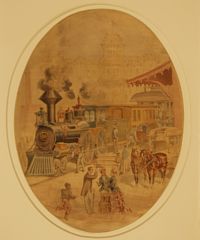
Train station with diamond stack engine, 1874 watercolor
Private Collection, photo Barbi Lare
He was very active in the town government of Rahway and served as the Clerk of the town and was a member of the Common Council. He was also active in the Masons and this interest continued throughout his life.
The Art of Harpers
Harper and Brothers started their weekly pictorial magazine in the 1850’s and by 1860, they needed someone to organize and superintend their Art Department. John R. was approached for the job and he accepted the challenge. Harpers Weekly continued from 1857 to 1912, exhibiting some of the finest examples of woodcut illustrations. (Examples of articles and illustrations can be found on line at www.harpweek.com.)
While at the magazine, John R., devised the block process of engraving which greatly facilitated the production of wood cuts. While at Harpers, he not only illustrated but also wrote articles. Some examples of them are, “Artist Life in the Highlands of New Jersey” (April 1860) and “The Westover Estate” (May 1871).
With the beginning of The Civil War in 1861, John R volunteered in the New Jersey Militia and was appointed a Captain. He was assigned to recruiting duties and he helped to train the batteries that he recruited. His daughter remembers seeing her father working in the library of their house with several men from the town, developing drills and military tactics using toy soldiers and horses that John R. had meticulously carved. They also relied on his extensive collection of books on the subject of war for these drills. During the Civil war, John R. illustrated several of A. H. Waud’s sketches sent in from the battles and one of these sketches, the surrender of Lee, is in the Library of Congress. Many of the important Generals passed through Rahway and stopped at the Chapin homestead. Hattie vividly remembers accompanying her father to the train to meet with Lincoln and his officers, to discuss the needs of the New Jersey Militia.
In 1864, Chapin painted his first large picture using India ink and watercolor to depict the death of Colonel McVicker of the 43rd N. J. Cavalry at the Spotsylvania Court House. He used an outline of a sketch of the battle and a photo of Colonel Mc Vicker obtained from one of the officers of the regiment. The regiment commissioned John R to do this picture. It was to hang in their drill room to show the love and respect they had for their fallen comrade. This was never to happen because in the later stages of the war, the regiment was wiped out. Chapin kept this painting and it survives today as a fine example of his many Civil war paintings.
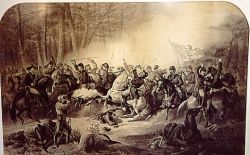
Death of Col. McVicker at the Spotsylvania Court House
Private Collection, photo Barbi Lare
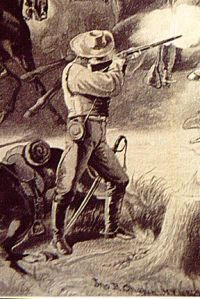
Detail of the sharpshooter bringing down Col. McVicker
Buffalo Bureau Bound
During the Years from 1865 to 1870 he ran his own Illustration and woodcut business in New York City, commuting to Rahway on the train. His company, The New York Bureau of Illustration employed six artists and 30 engravers at the height of its popularity. The main work involved illustrations for catalogues and these catalogues came out of the west (Chicago and Buffalo). Since this was the case, Chapin decided to move to Buffalo with his wife and 5 children to set up a branch of the Bureau of Illustration. They located the office in the old Chapin Block on the North side of Swan St. just off of Main Street toward the river and lived at 641 Prospect Avenue. He was also associated with Sage, Sons and Co. and was the Superintendent of their woodcut department for a few years.
While in Buffalo, their son, Charles Pierson Chapin attended the University of Buffalo, School of Medicine and became a General Practitioner. He made Buffalo his home and set up a practice on Ferry St. where he served the people of the West side until his untimely death in an automobile accident in 1937.
From 1873 to 1890 John R. and his family moved from Chicago to New York and then to Boston. He continued to work as an illustrator but there is not much information found about these years. He seemed to enjoy doing watercolors during this time and several have been kept in the family. (picture: Barn)
I would assume that he and his wife missed their children, as by then, they had all married and left home. In 1890, they moved back to Buffalo to live with Charles Pierson and his wife. During the first few years John R. worked for Matthews-Northrup Works as a designer and illustrator and finally retired in 1894. He continued painting in watercolor
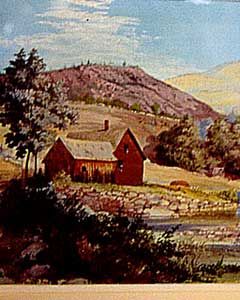
Chapin's watercolor of a scene titled, "Jamacia, 1886."
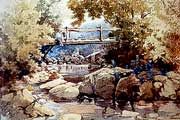
1893, watercolor painted while retired and living in Buffalo
and illustrating books (photo of Granger homestead) and doing free-lance illustrations for newspapers and magazines. His eldest son, Will E. Chapin was the art editor of the Los Angeles Times and he prevailed on his father to send him illustrations for that paper. Only eight days before his death, he sent off to California the drawing he had prepared for the mid-winter number of the Los Angeles Times.
While in their 70’s John and Martha undertook a train trip to California to visit Will and his family. It is difficult to imagine the rigors of this trip and they must have been in good health to even consider it. During the trip, he kept an art journal of sketches of the wonders that they observed crossing the country. In 1898, on the occasion of their 50th wedding Anniversary, he used these sketches and included one in every invitation that was sent out.
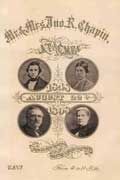
The Chapins' 50th wedding anniversary invitation
The invitation was beautifully designed by Chapin and included pictures of John and Martha at the time of their wedding on August 22, 1848 and also of them in 1898. Adelia Simmons from Rahway stated in her response to the invitation: “I think only an artist’s eye could have designed anything so beautiful, so perfect, as are also the dear familiar faces set in their golden circles”. The small watercolor sketches in the invitations were greatly prized by those who received them. One of his friends in Los Angeles, Mr. Hancock, wrote in his response: “On receiving this little jewel, I at once called your son, Will, who kindly went with me to select a frame that from an artists standpoint would be suitable for the picture. The painting now hangs in my office and is much admired.” What a prize it would be to find one of these sketches today.
John Reuben Chapin is a fine example of the type of interesting and talented people that have lived in and enriched the history of Western New York. His illustrations, writing, and artistic talents provide us with an insight into the exciting and innovative times during the 19th Century and are deserving of recognition.
Judy Chapin Buzby, a descendant of the illustrator, is a retired professor of nursing from Niagara County Community College after 22 years.